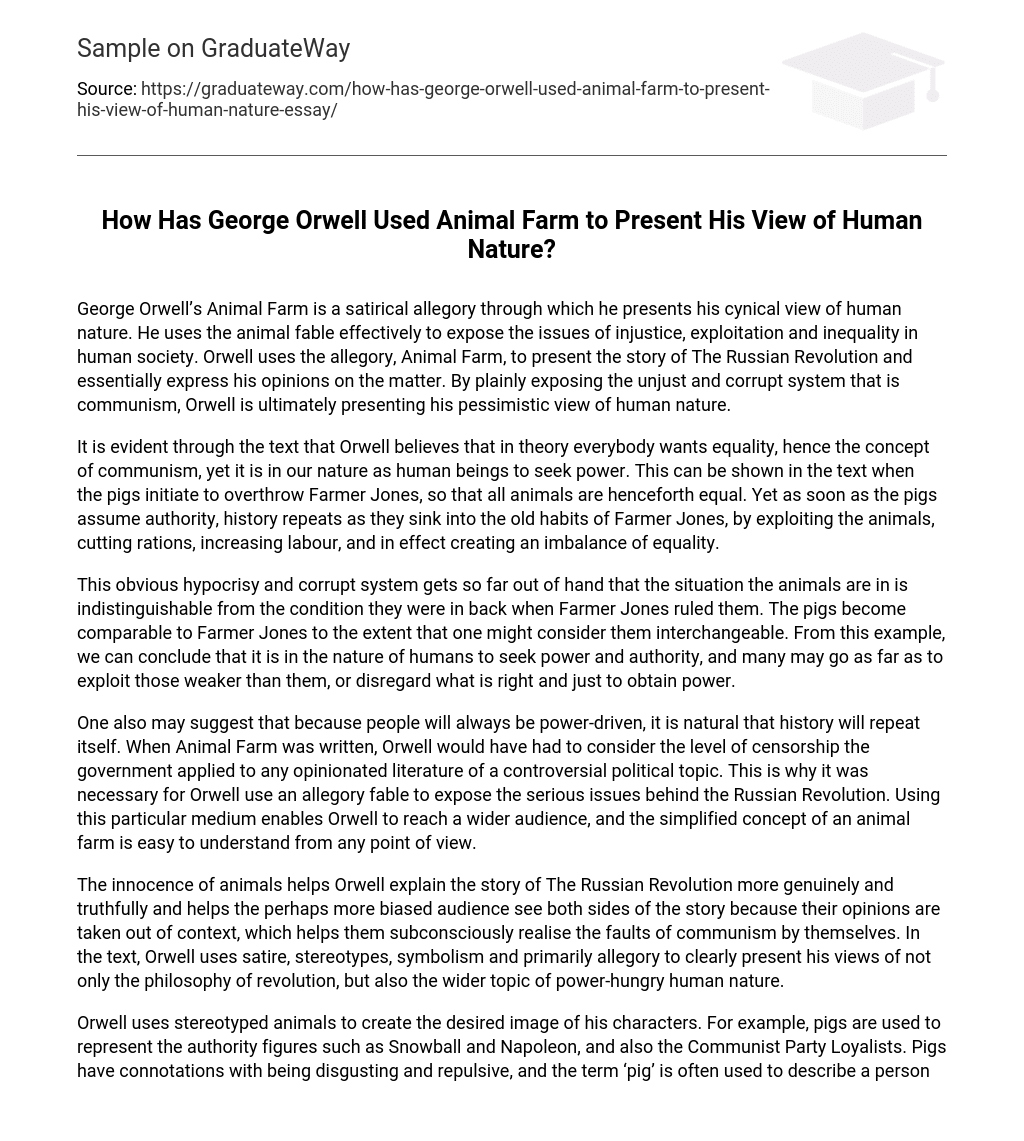George Orwell’s Animal Farm is a satirical allegory through which he presents his cynical view of human nature. He uses the animal fable effectively to expose the issues of injustice, exploitation and inequality in human society. Orwell uses the allegory, Animal Farm, to present the story of The Russian Revolution and essentially express his opinions on the matter. By plainly exposing the unjust and corrupt system that is communism, Orwell is ultimately presenting his pessimistic view of human nature.
It is evident through the text that Orwell believes that in theory everybody wants equality, hence the concept of communism, yet it is in our nature as human beings to seek power. This can be shown in the text when the pigs initiate to overthrow Farmer Jones, so that all animals are henceforth equal. Yet as soon as the pigs assume authority, history repeats as they sink into the old habits of Farmer Jones, by exploiting the animals, cutting rations, increasing labour, and in effect creating an imbalance of equality.
This obvious hypocrisy and corrupt system gets so far out of hand that the situation the animals are in is indistinguishable from the condition they were in back when Farmer Jones ruled them. The pigs become comparable to Farmer Jones to the extent that one might consider them interchangeable. From this example, we can conclude that it is in the nature of humans to seek power and authority, and many may go as far as to exploit those weaker than them, or disregard what is right and just to obtain power.
One also may suggest that because people will always be power-driven, it is natural that history will repeat itself. When Animal Farm was written, Orwell would have had to consider the level of censorship the government applied to any opinionated literature of a controversial political topic. This is why it was necessary for Orwell use an allegory fable to expose the serious issues behind the Russian Revolution. Using this particular medium enables Orwell to reach a wider audience, and the simplified concept of an animal farm is easy to understand from any point of view.
The innocence of animals helps Orwell explain the story of The Russian Revolution more genuinely and truthfully and helps the perhaps more biased audience see both sides of the story because their opinions are taken out of context, which helps them subconsciously realise the faults of communism by themselves. In the text, Orwell uses satire, stereotypes, symbolism and primarily allegory to clearly present his views of not only the philosophy of revolution, but also the wider topic of power-hungry human nature.
Orwell uses stereotyped animals to create the desired image of his characters. For example, pigs are used to represent the authority figures such as Snowball and Napoleon, and also the Communist Party Loyalists. Pigs have connotations with being disgusting and repulsive, and the term ‘pig’ is often used to describe a person who is heartily disliked. Therefore, it is appropriate that the corrupt authority figures should be allocated the characters of pigs on the farm, because the audience can easily recognise the characters’ personalities.
This technique is applied with other animal characters, such as horses, which are known to be hardworking, are represented as the submissive, unquestioning labourers, and sheep, which are identified as being gullible, obedient followers, are represented as people who readily accept propaganda without questioning the truth. Similarly, Orwell uses symbolism throughout the text, which aids the reader to interpret certain events in the fable as an event that actually happened in the Russian Revolution. For example, the windmill stands for the Russian industry.
In the text, the windmill was a mark of modernisation and an industrial advancement to the animals. So naturally, one would interpret this as the Soviet leaders making Russia industrially modern. Orwell makes excellent use of satire to effectively criticise human nature. This can be shown at the end of the text when the pigs mimic the human behaviour to such an extent that they ‘become’ them. The irony is that initially, human behaviour was precisely what revolted pigs and that they were fighting against humans in the first place.
Orwell uses the juxtaposition of comparing the animals and the humans side by side at the end of the story to point out this irony. The use of allegory to tell the story is effective because the fable can be interpreted to reveal the hidden political meaning. Not only does it invite the analysis of communism and the philosophy of revolution, but also the deeper layer of human nature. Thus, through Orwell’s use of language techniques, in the appropriate form of medium: the animal fable, Orwell has clearly articulated his cynical opinions and observations of the intricacies of human nature in the text, Animal Farm.





